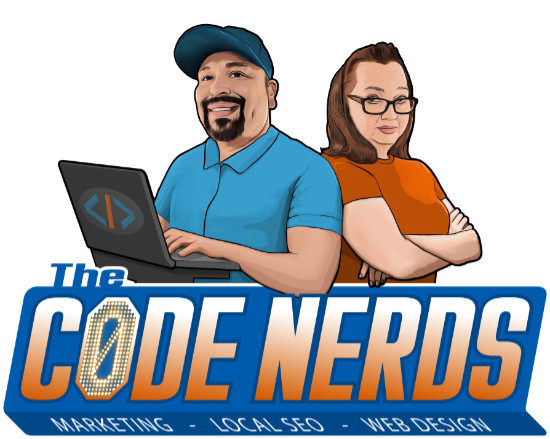The Code Nerds - Denver Web Design
3327 Brighton Blvd STE 51, Denver, CO 80216, United States
720-619-2383
https://goo.gl/maps/vtADHG72Z6bfUFL38
Boost Your Online Presence and Grow Your Brand's Authority with Our Marketing Playbook

Introduction
In today's hyperconnected digital landscape, establishing a strong online presence and cultivating brand authority has become essential for businesses striving to thrive and succeed. With consumers increasingly relying on the internet to research, discover, and make purchasing decisions, your brand's online presence plays a pivotal role in shaping perceptions and influencing customer behavior. This is where a well-crafted marketing playbook comes into play, acting as a comprehensive guide to strategically enhance your brand's online visibility and authority.
In this article, we will delve into the world of digital marketing and unveil a powerful marketing playbook that will empower your brand to soar above the competition and captivate your target audience. By implementing the strategies and tactics outlined in this playbook, you will be equipped to effectively boost your online presence, establish your brand as an industry authority, and ultimately drive growth and success.
So, let's embark on this journey to unleash the full potential of your brand in the digital realm. Together, we will explore proven techniques, expert insights, and practical steps to solidify your online presence and elevate your brand's authority. Get ready to harness the power of digital marketing and propel your brand to new heights of success.
Setting the Foundation: Understanding Your Target Audience
To establish a solid foundation for your marketing efforts, it is crucial to have a deep understanding of your target audience. By defining your target audience and gaining insights into their characteristics, preferences, and behaviors, you can tailor your marketing strategies to effectively connect with and engage them. Let's explore the key steps in setting this foundation and understanding your target audience.
- Defining your target audience and their characteristics:
- Identify the demographics of your ideal customers, such as age, gender, location, income level, and occupation.
- Consider psychographic factors, including interests, values, attitudes, and lifestyle choices.
- Segment your audience based on their needs, pain points, and motivations.
- Conducting market research and competitor analysis:
- Explore market trends, industry insights, and consumer behavior patterns.
- Analyze your competitors' strategies, strengths, weaknesses, and target audience.
- Identify gaps and opportunities in the market that your brand can leverage.
- Creating buyer personas to guide your marketing strategies:
- Develop detailed profiles of your ideal customers, representing different segments of your target audience.
- Include information such as demographics, interests, challenges, goals, and preferred communication channels.
- Use qualitative and quantitative data to inform your personas, such as surveys, interviews, and social media analytics.
By understanding your target audience, you can craft marketing messages, create relevant content, and choose appropriate channels that resonate with their needs and preferences. This targeted approach ensures that your marketing efforts are focused, effective, and efficient, maximizing your chances of connecting with and converting your ideal customers.
Remember, the foundation of successful marketing lies in a deep understanding of your target audience. Take the time to analyze, research, and develop buyer personas that will serve as your North Star throughout your marketing journey.
Developing a Strong Brand Identity
To establish a strong brand presence and resonate with your target audience, developing a cohesive and impactful brand identity is paramount. A well-defined brand identity serves as the foundation for all your marketing efforts, enabling you to effectively communicate your brand's values, differentiate yourself from competitors, and build lasting connections with your customers. Let's explore the key components of developing a strong brand identity.
- Defining your brand's mission, vision, and values:
- Clearly articulate the purpose and goals of your brand.
- Identify the core values that guide your business decisions.
- Craft a compelling mission statement and a forward-looking vision statement.
- Crafting a compelling brand story:
- Tell a narrative that encapsulates your brand's journey, values, and unique selling proposition.
- Highlight your brand's origin, inspirations, and the problems you aim to solve for your customers.
- Make it relatable, emotionally engaging, and aligned with your target audience's aspirations.
- Designing a visually appealing and consistent brand identity:
- Create a memorable and visually distinctive logo that represents your brand.
- Choose a cohesive color palette that conveys your brand's personality and resonates with your target audience.
- Select fonts and typography that align with your brand's tone and messaging.
- Implementing brand guidelines for all marketing materials:
- Develop a comprehensive set of guidelines that dictate the visual and verbal elements of your brand.
- Specify rules for logo usage, color schemes, typography, imagery, and tone of voice.
- Ensure consistency across all marketing channels, including your website, social media profiles, advertisements, and packaging.
By developing a strong brand identity, you establish a recognizable and trustworthy presence in the minds of your customers. It helps you create a cohesive brand experience, build brand loyalty, and differentiate yourself from competitors.
Remember, a compelling brand identity is not just about aesthetics but also about the values and emotions it evokes. Invest the time and effort to define and implement a strong brand identity that aligns with your target audience's aspirations and captures their hearts.
Building an Engaging Website
In today's digital landscape, a website serves as the cornerstone of your online presence and plays a pivotal role in shaping your brand's perception. To capture and retain the attention of your target audience, it is essential to build an engaging website that provides a seamless user experience. Let's explore the key elements of building an engaging website.
- Importance of a user-friendly and responsive website:
- Ensure your website is easy to navigate and intuitive, allowing users to find information effortlessly.
- Optimize loading speed to minimize bounce rates and provide a smooth browsing experience.
- Prioritize mobile responsiveness to cater to the growing number of users accessing the web on their smartphones and tablets.
- Optimizing website speed and performance:
- Compress images and optimize files to reduce page load times.
- Minimize the use of unnecessary scripts and plugins that may slow down your website.
- Leverage caching techniques and content delivery networks (CDNs) to enhance performance.
- Incorporating intuitive navigation and clear call-to-actions:
- Design a logical and user-friendly website navigation structure, ensuring visitors can easily find the information they seek.
- Implement clear and compelling call-to-action buttons to guide users toward desired actions, such as making a purchase or subscribing to a newsletter.
- Utilizing responsive design for mobile users:
- Adopt a responsive design approach that automatically adjusts the layout and elements of your website to fit various screen sizes.
- Optimize user experience on mobile devices by implementing mobile-friendly features, such as click-to-call buttons and simplified forms.
- Implementing search engine optimization (SEO) techniques:
- Conduct keyword research to identify relevant keywords and phrases your target audience is searching for.
- Optimize page titles, meta descriptions, headings, and image alt tags with targeted keywords.
- Create valuable and informative content that aligns with user search intent and incorporates relevant keywords.
Harnessing the Power of Content Marketing
Content marketing is a powerful strategy to engage your target audience, establish thought leadership, and drive organic traffic to your website. By creating high-quality and valuable content that resonates with your audience, you can build brand authority and foster meaningful connections. Let's explore how to harness the power of content marketing.
- Creating a content strategy aligned with your target audience's needs:
- Identify the pain points, interests, and information needs of your target audience.
- Develop a content plan that addresses these needs and provides valuable solutions.
- Determine the most effective content formats, such as blogs, articles, videos, or infographics, based on your audience's preferences.
- Producing high-quality and valuable content:
- Research and create content that offers unique insights, actionable tips, or entertainment value to your audience.
- Ensure your content is well-written, error-free, and visually appealing to capture and retain attention.
- Incorporate storytelling techniques and humanize your brand to establish an emotional connection with your audience.
- Optimizing content for search engines and keywords:
- Conduct keyword research to identify relevant keywords and phrases for each piece of content.
- Incorporate keywords naturally throughout your content, including in titles, headings, and body text.
- Use meta tags and descriptions that accurately reflect the content and entice users to click.
- Promoting content through social media channels:
- Share your content across relevant social media platforms to increase its reach and visibility.
- Engage with your audience by encouraging comments, shares, and likes.
- Leverage social media advertising to amplify the reach of your content to targeted audiences.
- Encouraging user-generated content and engagement:
- Foster a sense of community by encouraging users to share their experiences, opinions, and testimonials.
- Respond to comments and engage in conversations to build relationships and loyalty.
- Incorporate user-generated content, such as reviews or testimonials, to enhance credibility and social proof.
By implementing a comprehensive website strategy and leveraging the power of content marketing, you can create a captivating online presence that resonates with your audience, drives organic traffic, and fosters brand loyalty.
Leveraging Social Media Platforms
Social media has transformed the way brands connect with their audience, offering immense opportunities for engagement and brand growth. By leveraging the right social media platforms and implementing effective strategies, you can maximize your brand's visibility, foster meaningful connections, and drive conversions. Let's explore how to leverage social media platforms effectively.
- Identifying the most suitable social media platforms for your brand:
- Research and analyze different social media platforms to determine where your target audience is most active.
- Consider the demographics, interests, and behaviors of your target audience to select the platforms that align best with your brand.
- Establishing a consistent social media presence:
- Create and optimize professional social media profiles that reflect your brand's identity and values.
- Develop a consistent posting schedule to maintain a regular presence and engage your audience.
- Respond promptly to comments, messages, and inquiries to build trust and foster engagement.
- Creating engaging and shareable content for social media:
- Tailor your content to each social media platform, considering the format, tone, and preferences of the audience.
- Develop captivating visuals, compelling captions, and interactive elements to capture attention and encourage shares.
- Incorporate storytelling techniques and user-generated content to enhance engagement and authenticity.
- Utilizing social media Analytics to measure Performance:
- Utilize the analytics tools provided by each social media platform to track and measure key metrics, such as reach, engagement, and conversions.
- Analyze the data to gain insights into the effectiveness of your content, identify trends, and make data-driven decisions for future strategies.
- Building relationships with influencers and collaborating on campaigns:
- Identify influencers in your industry who align with your brand values and have a significant following.
- Establish relationships with influencers through engagement, collaborations, and partnerships.
- Collaborate on campaigns, sponsored content, or influencer takeovers to amplify your brand's reach and credibility.
Implementing Email Marketing Campaigns
Email marketing remains a powerful tool for nurturing leads, building relationships, and driving conversions. By implementing effective email marketing campaigns, you can engage your audience on a more personal level, deliver targeted messages, and achieve your business goals. Let's explore the key steps to implementing successful email marketing campaigns.
- Building an email subscriber list:
- Offer valuable incentives, such as exclusive content or discounts, to encourage visitors to subscribe to your email list.
- Leverage your website, social media channels, and other touchpoints to capture email addresses.
- Ensure compliance with privacy regulations and obtain proper consent for email marketing communications.
- Crafting personalized and targeted email campaigns:
- Segment your email list based on relevant criteria, such as demographics, past purchases, or engagement levels.
- Develop tailored email content that addresses the specific needs, preferences, and interests of each segment.
- Use personalization techniques to address subscribers by name and deliver highly relevant and engaging content.
Utilizing Search Engine Optimization (SEO)
Search engine optimization (SEO) is crucial for increasing your brand's visibility in search engine results and driving organic traffic to your website. By implementing effective SEO strategies, you can improve your website's ranking, attract targeted visitors, and grow your online presence. Let's explore how to utilize SEO effectively.
- Conducting keyword research and implementing on-page optimization:
- Research relevant keywords that align with your target audience's search intent and incorporate them strategically into your website's content.
- Optimize on-page elements such as titles, meta descriptions, headings, and URLs with targeted keywords.
- Ensure your website's content is valuable, informative, and aligned with user search queries.
- Creating valuable and informative content for organic search visibility:
- Develop high-quality content that addresses the needs, questions, and interests of your target audience.
- Incorporate relevant keywords naturally throughout your content, including in headings, subheadings, and body text.
- Use a variety of content formats, such as blog posts, articles, videos, or infographics, to cater to different user preferences.
By implementing effective social media strategies, email marketing campaigns and SEO techniques, you can significantly boost your online presence, engage your target audience, and drive meaningful results for your brand.
Tracking and Analyzing Results
Implementing effective marketing strategies is not enough without tracking and analyzing the results. By setting measurable goals and utilizing web analytics tools, you can gain valuable insights into the performance of your marketing efforts and make data-driven decisions to optimize your strategies. Let's explore how to track and analyze results effectively.
- Setting measurable goals and key performance indicators (KPIs):
- Clearly define your marketing goals, whether it's increasing website traffic, improving conversion rates, or expanding your social media reach.
- Establish specific KPIs that align with your goals and can be measured, such as the number of website visitors, email open rates, or social media engagement metrics.
- Utilizing web analytics tools to track website traffic and user behavior:
- Implement web analytics tools, such as Google Analytics, to track and analyze website traffic, user demographics, and behavior.
- Monitor metrics like page views, bounce rates, average session duration, and conversion rates to understand how users interact with your website.
- Analyzing social media metrics, email open rates, and click-through rates:
- Leverage the analytics provided by social media platforms to track the performance of your social media campaigns.
- Monitor metrics such as engagement rates, reach, impressions, and click-through rates to evaluate the effectiveness of your social media efforts.
- Analyze email marketing metrics, including open rates, click-through rates, and conversion rates, to assess the performance of your email campaigns.
- Making data-driven decisions and adjusting marketing strategies accordingly:
- Regularly review and analyze the collected data to identify trends, patterns, and areas for improvement.
- Use the insights gained from data analysis to make informed decisions and optimize your marketing strategies.
- Experiment with different approaches, test variations, and make necessary adjustments based on the results.
Final Thoughts
In today's competitive digital landscape, a comprehensive marketing playbook is essential for boosting your brand's authority and establishing a strong online presence. By understanding your target audience, developing a strong brand identity, utilizing various marketing channels, and analyzing the results, you can effectively grow your brand and achieve your business goals. Remember, consistency, adaptability, and a focus on delivering value are key to succeeding in the ever-evolving digital realm.
The Code Nerds - Denver Web Design
3327 Brighton Blvd STE 51, Denver, CO 80216, United States
720-619-2383
https://goo.gl/maps/vtADHG72Z6bfUFL38














